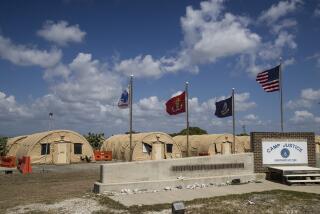Harsher Methods Fruitful, U.S. Says
- Share via
WASHINGTON — It didn’t take long for Mohammed Al-Qahtani’s American captors at the Guantanamo Bay naval base to conclude that he had mastered the art of resisting interrogations.
So they sought permission from Washington to treat the suspected Al Qaeda terrorist more harshly. And soon after Defense Secretary Donald H. Rumsfeld authorized the use of stronger interrogation methods in late 2002, Al-Qahtani allegedly spilled some important secrets.
Until the Americans turned tough, White House and Pentagon officials said Tuesday, Al-Qahtani had maintained that he was in Afghanistan to practice falconry.
Afterward, he confessed that he had met with Osama bin Laden several times. He said he knew one of the 19 Sept. 11 hijackers, and that he was to have been the 20th. And he supplied information on other terrorism suspects -- including Jose Padilla, who allegedly was scouting targets for a “dirty bomb” in the U.S., and Richard C. Reid, who was convicted of trying to blow up a Miami-bound passenger jet with explosives in his shoes.
During a briefing Tuesday, called by the White House to try to blunt global condemnation of Iraqi prisoner abuse, senior Bush administration officials described how a get-tough policy on suspected top Al Qaeda operatives had produced useful information. That policy then was revised amid concerns over abusive behavior by the captors.
The officials, including White House counsel Alberto R. Gonzales, maintained that even as authorities coveted tougher interrogation techniques, they meticulously sought higher approval -- and stayed within President Bush’s directive that interrogations be conducted in accordance with “American values,” as well as U.S. laws and international treaty obligations.
Still, the officials said Tuesday, as the number of prisoners quickly multiplied -- first in Afghanistan, then in Iraq -- U.S. officials were uncertain how gingerly to treat them.
“We were in essence in uncharted waters,” Daniel J. Dell’Orto, the Pentagon’s chief deputy general counsel, said of the situation at Guantanamo.
Officials declined to specify the tougher methods used on Al-Qahtani to get him to talk. But among the memos they released were three categories of “GTMO interrogation techniques” approved by Rumsfeld, with the harshest being “use of mild, noninjurious physical contact such as grabbing, poking in the chest with the finger and light pushing.”
Al-Qahtani tried to enter the United States on Aug. 4, 2001, just a month before the attacks; he was turned away at the airport in Orlando, Fla., by customs officials who considered the Saudi highly suspicious.
He arrived with no return ticket or hotel reservations, spoke little English, behaved menacingly and offered conflicting information on the purpose of his travel.
Authorities later determined that Mohamed Atta, the ringleader of the Sept. 11 attacks, was waiting at the airport to greet Al-Qahtani. But rather than risk being detained, Al-Qahtani, 26, boarded a return flight to Saudi Arabia. He later he made his way to Afghanistan, where he was captured.
The first prisoners from Afghanistan arrived at Guantanamo on Cuba in January 2002. By summer, U.S. authorities had concluded that they were holding some key Al Qaeda operatives and that they had been well-trained in resisting interrogations, Dell’Orto said.
On Oct. 11, 2002, authorities at the prison requested the three escalating categories of techniques beyond those listed in the Army field manual. The request soon ended up on Rumsfeld’s desk.
The new procedures took effect in December. But by late that month, concerns began surfacing at Guantanamo over the treatment of detainees, and a review procedure was launched in early January. The officials did not specify what prompted the review.
On Jan. 12, Rumsfeld rescinded his directive.
A second, more detailed review of the interrogation procedures was launched. Meantime, the questioning of Al-Qahtani was put on hold, Dell’Orto said.
That second review was completed in April, and Rumsfeld reissued his guidelines on April 16, approving 24 interrogation methods recommended to him by the chairman of the Joint Chiefs of Staff.
At the same time, Rumsfeld ordered that four techniques in particular could not be used without his personal approval in advance. These were the use of rewards or deprivation of privileges; attacking or insulting a prisoner’s ego; isolation; and alternating between friendly and harsh interrogators.
At no time was Bush involved in decisions over any specific interrogation techniques, Gonzales said.
Dell’Orto said that “less than a handful” of detainees at Guantanamo were subjected to the harsher techniques that were used on Al-Qahtani.
Times staff writer Greg Miller contributed to this report.
More to Read
Sign up for Essential California
The most important California stories and recommendations in your inbox every morning.
You may occasionally receive promotional content from the Los Angeles Times.










